Thermocouple connectors “TWINTOR”
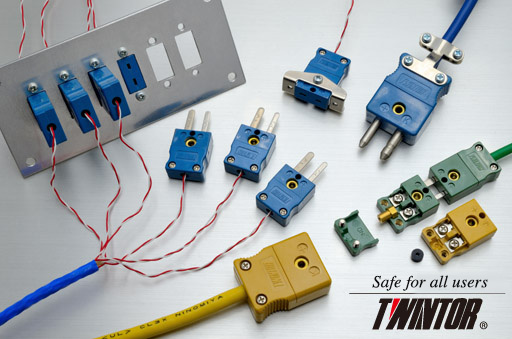
The thermocouple connectors, “TWINTOR,” are our original products, and there are no other products like these in Japan. The “TWINTOR” connectors adopt JIS Standard colors. Users can use a thermocouple, connector, and extension and compensating cable for thermocouples in the same color; this means that the “TWINTOR” connectors are super heat-resistant connectors that help to prevent problems such as wrong wiring and that ensure safe use by all users. We, as a manufacturer dedicated to supplying extension and compensating cables for thermocouples and duplex insulated thermocouple wire, utilizing our knowledge and technology of measuring thermoelectric temperature that we have accumulated over years, have developed the above thermocouple connectors to facilitate the easy use of thermocouples. “TWINTOR” is a registered trademark of our company.
STANDARD THERMOCOUPLE CONNECTORS
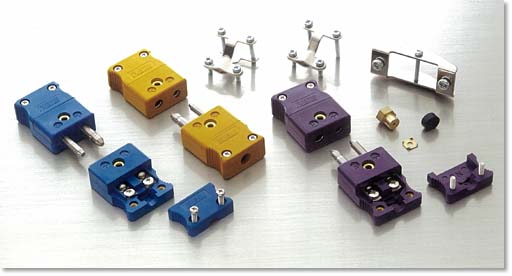
Outside diameters of usable sheaths: 2.8mm to 6.0mm
Outside diameters of usable conductors: Up to 1.0mm
| Type of thermocouple | Metal material used | Part No. (color in Section 2, JIS C1610-1995) | Part No. (color in ASTM E230 [former ANSI]) | |||||||
|---|---|---|---|---|---|---|---|---|---|---|
| Positive side | Negative side | Identification | Set | Plug | Jack | Identification | Set | Plug | Jack | |
| K | Chromel | Alumel | Blue | NDP-T01-K | NDP-P01-K | NDP-J01-K | Yellow | NDP-T01-KA | NDP-P01-KA | NDP-J01-KA |
| J | Steel | Copper-nickel alloy | Yellow | NDP-T01-J | NDP-P01-J | NDP-J01-J | Black | NDP-T01-JA | NDP-P01-JA | NDP-J01-JA |
| T | Copper | Copper-nickel alloy | Brown | NDP-T01-T | NDP-P01-T | NDP-J01-T | Blue | NDP-T01-TA | NDP-P01-TA | NDP-J01-TA |
| E | Chromel | Copper-nickel alloy | Purple | NDP-T01-E | NDP-P01-E | NDP-J01-E | Purple | NDP-T01-EA | NDP-P01-EA | NDP-J01-EA |
| R* | Copper | Copper alloy | Black | NDP-T01-R | NDP-P01-R | NDP-J01-R | Green | NDP-T01-RA | NDP-P01-RA | NDP-J01-RA |
*We can offer connectors with colors specified in JIS C1610-2012.
*For the connection part of TWINTOR for R-type thermocouple, the material used for extension and compensating cables for thermocouples is used.
When placing an order, please specify the “NDP” part No. described in the above table.
Connector

Adapter
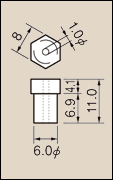
Cable clamp
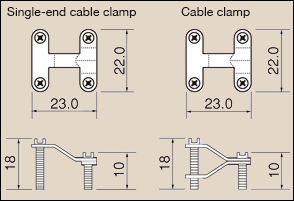
Panel fitting

Square washer

| Standard connector | Part No. |
|---|---|
| Cable clamp | NDC-S |
| Single-end cable clamp | NDC-SS |
| Adapter | NDA-S |
| Panel fitting | NDP-S |
| Square washer | NDW-S |
MINIATURE THERMOCOUPLE CONNECTORS
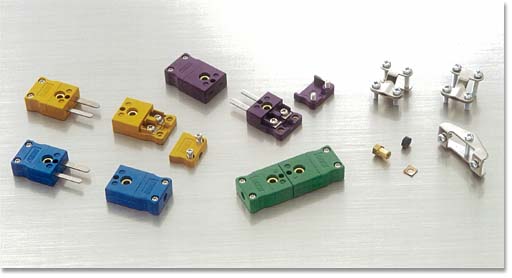
Outside diameters of usable sheaths: 0.5mm to 4.0mm
Outside diameters of usable conductors: Up to 0.5mm
| Type of thermocouple | Metal material used | Part No. (color in Section 2, JIS C1610-1995) | Part No. (color in ASTM E230 [former ANSI]) | |||||||
|---|---|---|---|---|---|---|---|---|---|---|
| Positive side | Negative side | Identification | Set | Plug | Jack | Identification | Set | Plug | Jack | |
| K | Chromel | Alumel | Blue | NDP-T02-K | NDP-P02-K | NDP-J02-K | Yellow | NDP-T02-KA | NDP-P02-KA | NDP-J02-KA |
| J | Steel | Copper-nickel alloy | Yellow | NDP-T02-J | NDP-P02-J | NDP-J02-J | Black | NDP-T02-JA | NDP-P02-JA | NDP-J02-JA |
| T | Copper | Copper-nickel alloy | Brown | NDP-T02-T | NDP-P02-T | NDP-J02-T | Blue | NDP-T02-TA | NDP-P02-TA | NDP-J02-TA |
| E | Chromel | Copper-nickel alloy | Purple | NDP-T02-E | NDP-P02-E | NDP-J02-E | Purple | NDP-T02-EA | NDP-P02-EA | NDP-J02-EA |
| R* | Copper | Copper alloy | Black | NDP-T02-R | NDP-P02-R | NDP-J02-R | Green | NDP-T02-RA | NDP-P02-RA | NDP-J02-RA |
*We can offer connectors with colors specified in JIS C1610-2012.
*For the connection part of TWINTOR for R-type thermocouple, the material used for extension and compensating cables for thermocouples is used.
When placing an order, please specify the “NDP” part No. described in the above table.
Connector

Adapter

Cable clamp

Panel fitting
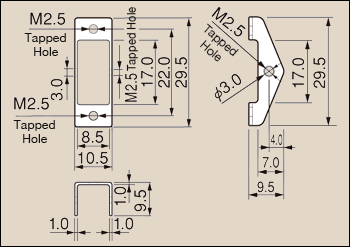
Square washer

Panel (6P specification) *Dedicated to miniature connectors
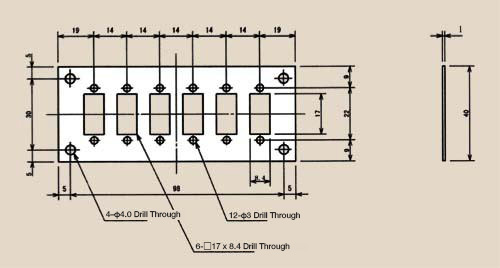
Panel specifications
Material = Aluminum (a thickness of about 1.0mm)
Surface treatment of the panel = Anodized aluminum with hair lines
Mounting hole size = 86mm x 31mm (recommended size)
Screw hole = M3.5
Click here to see the PDF catalogue
Photo of the panel (example of a combination with TWINTOR)
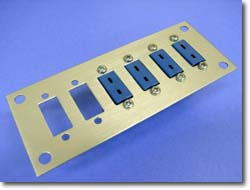
Adapter
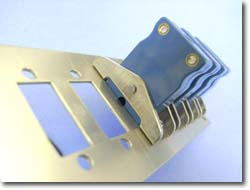
| Miniature connector | Part No. |
|---|---|
| Cable clamp | NDC-M |
| Single-end cable clamp | NDC-MS |
| Adapter | NDA-M |
| Panel fitting | NDP-M |
| Panel (6P specification) | NDH-M-6 |
| Square washer | NDW-M |
Examples of thermocouple connector “TWINTOR” usage
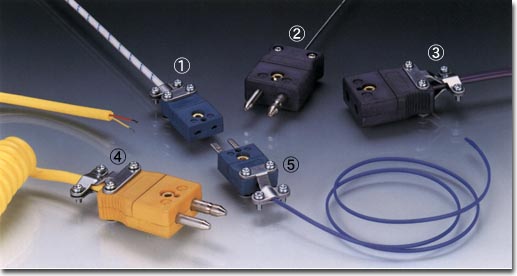
- Connector: NDP-J02-K
Connected to a duplex insulated thermocouple wire (0.32 x1P K-H) - Connector: NDP-P01-E
Connected to a sheath thermocouple - Connector: NDP-J01-E
Connected to an extension and compensating cable for thermocouples (7/0.3 x1P EX-G) - Connector: NDP-P01-KA
Connected to an extension and compensating cable for thermocouples (curl processed and compliant with ASTM Standards) (7/0.1 x1P KX-SR) - Connector: NDP-P02-K
Connected to a duplex insulated thermocouple wire (0.32 x1P K-6F)
General specifications of the products
- Housing
Material: PPS
Heat-resistant temperature range: -50℃ to +260℃
Continuous use temperature: Equal to or higher than +220℃
Incombustibility: UL94V0
Insulation resistance: 4×1016Ω∙cm
Chemical resistance: Excellent chemical resistance comparable to that of fluorine resin. Excellent resistivity to general organic solvents.
Oil resistance: Excellent resistivity to mineral oil, grease, diesel oil, and gas oil
* PPS that is used for the housing may have slightly different colors depending on the production lot due to its characteristics,
but this does not affect the product performance. - Connection part
For the connection part, a material for thermocouples* is used. No special material correction is required. In addition, even when the ambient temperature is unstable, accurate measurement can be performed.
*For the connection part of TWINTOR for R-type or S-type thermocouple, the material used for extension and compensating cables for thermocouples is used. - Tightening torque
Do not overtighten the screws. We recommend that the appropriate tightening torque be 8.9cN∙m. We recommend that the maximum tightening torque be 16cN∙m.
If a screw is tightened with a torque exceeding 16cN∙m, the housing or other parts may be broken. Please exercise care when tightening the screws. - Cable clamps
We offer two types of cable clamps: Double-end clamps (NDC-M) and single-end clamps (NDC-MS). For normal use, we recommend using single-end clamps (NDC-MS).
Frequently asked questions (FAQ)
The questions frequently asked regarding “TWINTOR” are described below.
- What is the minimum number of products to be supplied?
- Do the colors of the “TWINTOR” connectors comply with the new JIS colors (Category-1 colors defined by JIS)?
- Does a plug, jack, or set come with any accessories?
- Our company is now using imported connectors. Are your connectors interchangeable with the ones we are using?
- How can I use cable clamps?
- Your company is offering two types of cable clamps: Double-end clamps and single-end clamps. What is the difference between them?
- What are the outside diameters of usable conductors of wire and the outside diameters of usable sheaths?
- How can I use panel fittings?
- How can I use adapters (1.0 mm hole diameter, made of brass)?
- How can I use square washers?
- Does your company specify torque for tightening screws?
- Do the “TWINTOR” connectors comply with the RoHS Directive?
- Do the “TWINTOR” connectors comply with the China RoHS?
- Q. What is the minimum number of products to be supplied?
A. You can purchase one product or more. You can purchase one plug, jack, or set. - Q. Do the colors of the “TWINTOR” connectors comply with the new JIS colors (Category-1 colors defined by JIS)?
A. Some colors comply with the new JIS colors. For popular products, we plan to phase in new colors in compliance with the new JIS colors. - Q. Does a plug, jack, or set come with any accessories?
A. Each of them comes with rubber packing for routing electric wire. - Q. Our company is now using imported connectors. Are your connectors interchangeable with the ones we are using?
A. Some of our connectors are interchangeable with imported connectors. However, since imported connectors vary greatly, the interchangeability between our connectors and imported connectors may differ depending on factors such as the time of the production of the imported connectors. Such differences may occur even when the imported connectors are made by a single manufacturer. For details, please contact our Sales Department. - Q. How can I use cable clamps?
A. Use cable clamps to fix extension and compensating cables for thermocouples and duplex insulated thermocouple wire, which are connected to the “TWINTOR” connectors, to prevent them from coming off. - Q. Your company is offering two types of cable clamps: Double-end clamps and single-end clamps. What is the difference between them?
A. A double-end clamp fixes an electric wire from both sides. A single-end clamp also fixes an electric wire from both sides, but fixes the “TWINTOR” connector from one side. We recommend using single-end clamps. - Q. What are the outside diameters of usable conductors of wire and the outside diameters of usable sheaths?
A. Please refer to the table below.Outside diameter of sheath (mm) Outside diameter of conductor (mm) Standard 2.8 to 6.0 0.3 to 1.0 Miniature 0.5 to 4.0 0.05 to 0.5 Use the thermocouple wire or extension and compensating cable for thermocouples whose size matches the “TWINTOR” connector to be used.
If the size of the wire or cable does not match the size of the “TWINTOR” connector, (a) the wire or cable cannot be connected to the “TWINTOR” connector; (b) adequate attachment strength may not be attained; (c) the wire or cable or the “TWINTOR” connector may be broken; or (d) other problems may occur. - Q. How can I use panel fittings?
A. Use panel fittings to fix “TWINTOR” connectors onto objects such as panels of devices. Insert the attached screws into the eyelet holes of the “TWINTOR” connector to fix it.
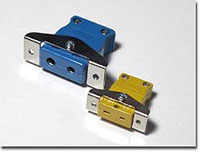
- Q. How can I use the adapter (1.0 mm hole diameter, made of brass)?
A. Use the adapter to fix the metal sheath of a sheath thermocouple, etc. Weld the metal sheath to the adapter. - Q. How can I use square washers?
A. Insert a square washer between the screw and the “TWINTOR” pin to fix conductors. Two square washers are required for each plug and jack.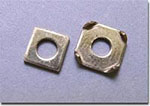
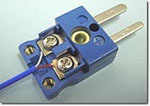
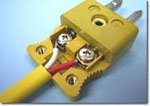
*In the above photos, the rubber packing is removed to allow the reader to clearly see the square washers.
- Q. Does your company specify torque for tightening screws?
A. The tightening torque that we recommend is “approx. 8.9CN/m.” The maximum tightening torque that we recommend is “approx. 16CN/m.” If torque exceeding the maximum tightening torque is applied, the “TWINTOR” connector may break. We recommend using a torque screw driver. - Q. Do the “TWINTOR” connectors comply with the RoHS Directive?
A. Yes, they do. - Q. Do the “TWINTOR” connectors comply with the China RoHS?
A. Unlike the EU RoHS Directive, the China RoHS allows the regulation values to be exceeded, but basically requires an indication of whether or not the product contains any of the six specified hazardous substances. A part (an insertion nut that is mainly made of brass) used for the “TWINTOR” connectors contains lead, the content of which exceeds the value regulated in the China RoHS (Note: For the EU RoHS Directive, this is included in the Exemption List). Before bringing a “TWINTOR” connector or a device incorporating a “TWINTOR” connector into China, the user must judge whether the connector or device contains the six specified hazardous substances. When bringing the connector or device into China, the user must present a document which proves whether the connector or device contains the six specified hazardous substances. We can provide a document about the parts of“TWINTOR” that contain the six specified hazardous substances. Therefore, please contact our Sales Department.
Note: The six specified hazardous substances (cadmium, hexavalent chromium, lead, mercury, polybrominated biphenyls [PBB], and polybrominated diphenyl ether [PBDE]) and regulation values (threshold values) that the EU RoHS Directive specifies are the same as those that the China RoHS specifies. However, although the EU RoHS Directive contains the EU RoHS Exemption List which describes that steel materials, aluminum alloy, and copper alloy are exemptions, the China RoHS does not specify such exemptions.

